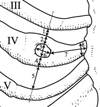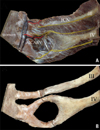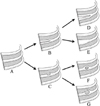1. White TD, Folkens PA. Human osteology. 2000. 2nd ed. San Diego: Academic press;29.
2. Steiner HA. Roentgenologic manifestations and clinical symptoms of rib abnormalities. Radiology. 1943. 40:175–178.

3. Etter LE. Osseous abnormalities of thoracic cage seen in forty thousand consecutive chest photoroentgenograms. Am J Roentgenol. 1944. 51:359–363.
4. Martin EJ. Incidence of bifidity and related rib abnormalities in Samoans. Am J Phys Anthropol. 1960. 18:179–187.

5. Lim CK, Lee KW, Bin JC, Rhee BC. Congenital anomalies of the ribs. J Korean Soc Plast Reconstr Surg. 1982. 18:487–495.

6. Schumacher R, Mai A, Gutjahr P. Association of rib anomalies and malignancy in childhood. Eur J Pediatr. 1992. 151:432–434.

7. Huang JH, Zager EL. Thoracic outlet syndrome. Neurosurgery. 2004. 55:897–902. discussion 902-3.

8. Batra D, Lawner BJ. Bifid fifth rib in a 9-year-old girl with chest pain. J Am Osteopath Assoc. 2006. 106:359–360.
9. Gorlin RJ, Goltz RW. Multiple nevoid basal-cell epithelioma, jaw cysts and bifid rib. A syndrome. N Engl J Med. 1960. 262:908–912.

10. Koutnik AW, Kolodny SC, Hooker SP, Roche WC. Multiple nervoid basal cell epithelioma, cysts of the jaw, and bifid rib syndrome: report of case. J Oral Surg. 1975. 33:686–689.
11. Wattanasirichaigoon D, Prasad C, Schneider G, Evans JA, Korf BR. Rib defects in patterns of multiple malformations: a retrospective review and phenotypic analysis of 47 cases. Am J Med Genet A. 2003. 122A:63–69.
12. Osawa T, Onodera M, Feng XY, Sasaki N, Nagato S, Matsumoto Y, et al. Two cases of bifid ribs observed in the fourth and the fifth rib. Dental J Iwate Med Univesity. 2002. 27:98–103.
13. Osawa T, Sasaki T, Matsumoto Y, Tsukamoto A, Onodera M, Nara E, et al. Bifid ribs observed in the third and the fourth ribs. Kaibogaku Zasshi. 1998. 73:633–635.
14. Charles I, Scott J. Stevenson RE, Hall JG. Pectoral girdle, spines, ribs, and pelvic girdle. Human malformations and related anomalies. 1993. Vol. 2. New York: Oxford University Press;655–697.
15. Bergman RA, Thompson SA, Afifi AK, Saadeh FA. Compendium of human anatomic variation. 1988. Baltimore: Urban & Schwarzenbergl;204–205.
16. Oostra RJ, Maas M. Bifid ribs and unusual vertebral anomalies diagnosed in an anatomical specimen. Gorlin syndrome? Am J Med Genet A. 2006. 140:2135–2138.





 PDF
PDF ePub
ePub Citation
Citation Print
Print







 XML Download
XML Download